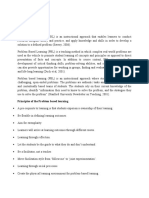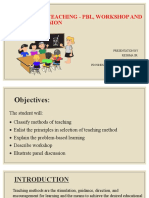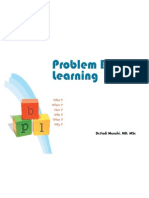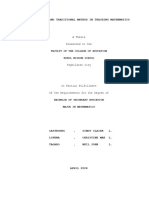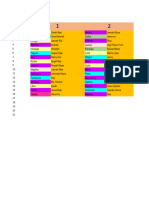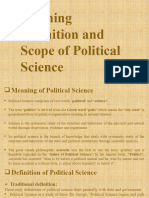Enhanced-Problem-Based-Learning
Uploaded by
Christine LopenaEnhanced-Problem-Based-Learning
Uploaded by
Christine LopenaProblem-Based Learning (PBL): A Transformative Approach to Education
Problem-Based Learning (PBL) is a dynamic and student-centered teaching method that
shifts the focus of learning from traditional lectures to the active pursuit of knowledge through
problem-solving. In PBL, students are confronted with real-world, open-ended problems and are
tasked with finding solutions by drawing on their existing knowledge, researching new
information, and collaborating with peers. Rather than passively absorbing information from a
lecture, students engage with the material in a more meaningful, hands-on way, taking
responsibility for their own learning.
This approach fosters the development of critical thinking, teamwork, self-directed learning, and
communication skills, all of which are essential in both academic and professional settings. PBL
has been successfully implemented across a wide range of disciplines, including medical
education, business, engineering, and the social sciences.
Core Features of PBL
1. Student-Centered Learning: Students take charge of their learning, guided by the problem
at hand. They identify what they know, what they need to know, and how to acquire the
necessary information.
2. Collaboration and Teamwork: PBL is often conducted in small groups, where students
collaborate, share insights, and solve problems together. This promotes the development
of interpersonal skills and the ability to work effectively in teams.
3. Real-World Problem Solving: The problems presented in PBL are often complex, ill-
structured, and closely related to real-world scenarios. This ensures that students can see
the practical application of their learning.
4. Self-Directed Learning: PBL encourages students to take ownership of their learning. They
must independently seek out information, identify gaps in their knowledge, and fill those
gaps through research and inquiry.
5. Facilitator Role of Instructors: In PBL, the instructor acts as a facilitator or mentor, rather
than a traditional lecturer. The instructor guides students through the problem-solving
process, offering support, feedback, and direction as needed, but refrains from providing
direct answers.
The PBL Process: Step-by-Step (The steps can be repeated and recycled)
1. Explore the issues:
Your teacher introduces an "ill-structured" problem to you.
Discuss the problem statement and list its significant parts.
You may feel that you don't know enough to solve the problem but that is the challenge!
You will have to gather information and learn new concepts, principles, or skills as you
engage in the problem-solving process.
2. List "What do we know?"
What do you know to solve the problem?
This includes both what you actually know and what strengths and capabilities each team
member has.
Consider or note everyone's input, no matter how strange it may appear: it could hold a
possibility!
3. Develop, and write out, the problem statement in your own words:
A problem statement should come from your/the group's analysis of what you know, and
what you will need to know to solve it. You will need:
a written statement
the agreement of your group on the statement
feedback on this statement from your instructor.
(This may be optional, but is a good idea)
Note: The problem statement is often revisited and edited as new information is
discovered, or "old" information is discarded.
4. List out possible solutions
List them all, then order them from strongest to weakest
Choose the best one, or most likely to succeed
5. List actions to be taken with a timeline
What do we have to know and do to solve the problem?
How do we rank these possibilities?
How do these relate to our list of solutions?
Do we agree?
6. List "What do we need to know?"
Research the knowledge and data that will support your solution you will need to
information to fill in missing gaps.
Discuss possible resources
Experts, books, web sites, etc.
Assign and schedule research tasks, especially deadlines
7. Write up your solution with its supporting documentation, and submit it.
You may need to present your findings and/or recommendations to a group or your
classmates.
This should include the problem statement, questions, data gathered, analysis of data,
and support for solutions or recommendations based on the data analysis: in short, the
process and outcome.
Presenting and defending your conclusions:
The goal is to present not only your conclusions, but the foundation upon which they rest.
Prepare to…
State clearly both the problem and your conclusion
Summarize the process you used, options considered, and difficulties encountered
Convince, not overpower
Bring others to your side, or to consider without prejudice your supporting documentation
and reason
Help others learn, as you have learned
If challenged
and you have an answer, present it clearly
and you don't have an answer, acknowledge it and refer it for more consideration
Sharing your findings with teachers and students is an opportunity in demonstrating that you
have learned. If you know your subject well, this will be evident. If a challenge arises that you
cannot respond to, accept it as an opportunity to be explored. However, take pride in your
attention to quality when you present. See also the Guide on presenting projects.
8. Review your performance
This debriefing exercise applies both to individuals and the group.
Take pride in what you have done well; learn from what you have not done well. Thomas
Edison took pride in unsuccessful experiments as part of his journey to successful
outcomes!
9. Celebrate your work!
Problem Based Learning (PBL)
Problem-based learning (PBL) is a method of learning and teaching which allows students
to focus on how and what they will learn. An unfamiliar problem, situation or task is presented to
the students (by the lecturer or tutor) and students are required to determine for themselves
how they will go about solving the problem. This usually occurs through small group work and
allows students to utilise their prior knowledge in the topic area and identify the gaps in their
knowledge as they attempt to solve the problem.
PBL is a student-centred approach to learning that encourages students to be self-
directed, interdependent and independent as they attempt to solve the set problem.
Problem-based learning (PBL) is both a teaching method and an approach to the
curriculum. It consists of carefully designed problems that challenge students to use problem
solving techniques, self-directed learning strategies, team participation skills, and disciplinary
knowledge. The articles and links in this section describe the characteristics and objectives of
PBL and the process for using PBL. There is also a list of printed and web resources.
Problem-Based Learning: Benefits and Risks
By: Maryellen Weimer, PhD
Problem-based learning, the instructional approach in which carefully constructed, open-
ended problems are used by groups of students to work through content to a solution, has
gained a foothold in many segments of higher education.
Originally PBL, as it’s usually called, was used in medical school and in some business
curricula for majors. But now it is being used in a wide range of disciplines and with students at
various educational levels. The article (reference below) from which material is about to be cited
“makes a critical assessment” of how PBL is being used in the field of geography.
Much of the content is relevant to that discipline specifically, but the article does contain a
useful table that summarizes the benefits and risks of PBL for students, instructors, and
institutions. Material on the table is gleaned from an extensive review of the literature (all
referenced in the article). Here’s some of the information contained in the table.
Benefits of Problem-Based Learning
For Students:
Enhanced Engagement and Motivation: PBL makes learning more relevant and interesting
by connecting academic content to real-world challenges.
Critical Thinking and Problem-Solving Skills: Students develop the ability to analyze
complex problems, evaluate solutions, and think critically—skills that are valuable in both
academic and professional settings.
Collaboration and Communication: Working in groups fosters interpersonal skills, including
teamwork, negotiation, and conflict resolution. Students also improve their ability to
communicate ideas clearly, both orally and in writing.
Self-Directed Learning: PBL encourages students to take responsibility for their learning.
They gain confidence in their ability to seek out information, solve problems
independently, and learn how to learn.
Real-World Application: By solving real-world problems, students can see the direct
relevance of what they are learning and how it applies outside the classroom.
For Instructors:
Active Student Participation: PBL tends to increase student engagement and participation,
as students are more involved in the learning process.
Higher Quality Learning: PBL promotes deeper learning and understanding, as students
are actively involved in constructing their knowledge.
Intrinsic Rewards: Teaching in a PBL environment can be more satisfying for instructors, as
they see students develop critical thinking and problem-solving skills through collaborative
inquiry.
Encourages Interdisciplinary Learning: PBL problems often require students to integrate
knowledge from multiple disciplines, fostering interdisciplinary learning and thinking.
For Institutions:
Improved Retention Rates: PBL has been shown to improve student retention by fostering
a more engaging and meaningful learning experience.
Enhanced Reputation: Institutions that adopt innovative, student-centered learning
methods like PBL can build a reputation for offering high-quality, cutting-edge education.
Support for Lifelong Learning: PBL helps develop skills that prepare students for lifelong
learning, making them more adaptable to changes in their careers and personal lives.
Risks of Problem-Based Learning
For Students
Prior learning experiences do not prepare students well for PBL.
PBL requires more time and takes away study time from other subjects.
It creates some anxiety because learning is messier.
Sometimes group dynamics issues compromise PBL effectiveness.
Less content knowledge may be learned.
For Instructors
Creating suitable problem scenarios is difficult.
It requires more prep time.
Students have queries about the process.
Group dynamics issues may require faculty intervention.
It raises new questions about what to assess and how.
For Institutions
It requires a change in educational philosophy for faculty who mostly lecture.
Faculty will need staff development and support.
It generally takes more instructors.
It works best with flexible classroom space.
It engenders resistance from faculty who question its efficacy.
Problem-based learning (PBL) is a student-centered approach in which students learn about a
subject by working in groups to solve an open-ended problem.
The problem is what drives the motivation and the learning.
Rather than teaching relevant material and subsequently having students apply the knowledge
to solve problems, the problem is presented first. Students generally must:
Examine and define the problem.
Explore what they already know about underlying issues related to it.
Determine what they need to learn and where they can acquire the information and tools
necessary to solve the problem.
Evaluate possible ways to solve the problem.
Solve the problem.
Report on their findings.
PBL assignments can be short, or they can be more involved and take a whole semester.
PBL is often group oriented, so it is beneficial to set aside classroom time to prepare students
to work in groups and to allow them to engage in their PBL project.
Why use problem-based learning?
Nilson (2010, p. 190) lists learning outcomes associated with PBL. A well-design PBL project
provides students with the opportunity to develop skills related to:
Working in teams.
Managing projects and holding leadership roles.
Oral and written communication.
Self-awareness and evaluation of group processes.
Working independently.
Critical thinking and analysis.
Explaining concepts.
Self-directed learning.
Applying course content to real world examples.
Researching and information literacy.
Problem solving across disciplines.
What are the basic steps in designing a PBL project?
Articulate the learning outcomes of the project. What do you want students to know or be able
to do as a result of participating in the assignment?
Create the problem. Ideally, this will be a real-world situation that resembles something
students may encounter in their future careers or lives. Cases are often the basis of PBL
activities.
Establish ground rules at the beginning to prepare students to work effectively in groups.
Introduce students to group processes and do some warm up exercises to allow them to
practice assessing both their own work and that of their peers.
Consider having students take on different roles or divide up the work up amongst themselves.
Alternatively, the project might require students to assume various perspectives, such as those
of government officials, local business owners, etc.
Establish how you will evaluate and assess the assignment. Consider making the assessments
students make of their own work and that of their peers part of the assignment grade.
References:
http://www.studygs.net/pbl.htm
https://www.flinders.edu.au/teaching/quality/teaching-methods/problem-based-
learning.cfm
http://www.crlt.umich.edu/tstrategies/tspbl
http://www.facultyfocus.com/articles/effective-teaching-strategies/problem-based-learning-
benefits-and-risks/
You might also like
- Children'S Books in Children'S Hands: Temple Martinez Yokota Naylor100% (2)Children'S Books in Children'S Hands: Temple Martinez Yokota Naylor616 pages
- How to Teach Anything: Break Down Complex Topics and Explain with Clarity, While Keeping Engagement and MotivationFrom EverandHow to Teach Anything: Break Down Complex Topics and Explain with Clarity, While Keeping Engagement and Motivation4.5/5 (4)
- Problem Based Learning Integrating 21 Century Skills: Prepared By:-Alamelu Manggai Ponnusamy Santha Kumari KrishnanNo ratings yetProblem Based Learning Integrating 21 Century Skills: Prepared By:-Alamelu Manggai Ponnusamy Santha Kumari Krishnan18 pages
- By Working With PBL, Students Will:: (I.e., What Is It That You Want Your Students To ReallyNo ratings yetBy Working With PBL, Students Will:: (I.e., What Is It That You Want Your Students To Really5 pages
- Advantages of PBL: Roblem-Based Learning: PBL Is Any Learning Environment in Which The Problem DrivesNo ratings yetAdvantages of PBL: Roblem-Based Learning: PBL Is Any Learning Environment in Which The Problem Drives4 pages
- Problem Solving and Problem Based LearningNo ratings yetProblem Solving and Problem Based Learning30 pages
- Problem-Based Learning: Presented by M S.jalpa G Patel F.Y.M .SC (N)100% (1)Problem-Based Learning: Presented by M S.jalpa G Patel F.Y.M .SC (N)37 pages
- Problem Based Learning: Effective Teaching GuideNo ratings yetProblem Based Learning: Effective Teaching Guide5 pages
- Accelerated Learning Techniques: Unlimited Photographic Memory Mastery and Memory ImprovementFrom EverandAccelerated Learning Techniques: Unlimited Photographic Memory Mastery and Memory ImprovementNo ratings yet
- assignment on Problem-Based L-WPS OfficeNo ratings yetassignment on Problem-Based L-WPS Office5 pages
- ELIC328 Labs: Problem-Based Learning (PBL) ApproachNo ratings yetELIC328 Labs: Problem-Based Learning (PBL) Approach7 pages
- Blueprint For Thoughtful Lesson Planning: Excavating For Conceptual UnderstandingFrom EverandBlueprint For Thoughtful Lesson Planning: Excavating For Conceptual UnderstandingNo ratings yet
- Problem Based Learning and Thinking Based Learning100% (1)Problem Based Learning and Thinking Based Learning20 pages
- Teach Like Nobody's Watching: The essential guide to effective and efficient teachingFrom EverandTeach Like Nobody's Watching: The essential guide to effective and efficient teachingNo ratings yet
- What Is Project Based Learning and Problem Based LearningNo ratings yetWhat Is Project Based Learning and Problem Based Learning5 pages
- Learning & Study Guide for Adult Students: Teacher's ManualFrom EverandLearning & Study Guide for Adult Students: Teacher's ManualNo ratings yet
- Transform Adult Education: Expert Teaching Strategies for EducatorsFrom EverandTransform Adult Education: Expert Teaching Strategies for Educators5/5 (2)
- 2.seminar MOT - PBL, Workshop, Panel Discussion-3100% (1)2.seminar MOT - PBL, Workshop, Panel Discussion-358 pages
- Methods of Teaching Mathematics: A. Situation-Based Learning B. Problem-Based LearningNo ratings yetMethods of Teaching Mathematics: A. Situation-Based Learning B. Problem-Based Learning20 pages
- Technology For Teaching and Learning: Elementary GradesNo ratings yetTechnology For Teaching and Learning: Elementary Grades9 pages
- Nature-of-Project-Based-and-Problem-Based-Approaches-in-Language-TeachingGroup-3 (2)No ratings yetNature-of-Project-Based-and-Problem-Based-Approaches-in-Language-TeachingGroup-3 (2)14 pages
- Problem Based Learning: Nama Pensyarah: En. Baskaran A/L Subramaniam Nama: Nur Izzati Binti Mohd Khalil (B&K1)No ratings yetProblem Based Learning: Nama Pensyarah: En. Baskaran A/L Subramaniam Nama: Nur Izzati Binti Mohd Khalil (B&K1)16 pages
- Cracks_in_problem_based_learning_What_isNo ratings yetCracks_in_problem_based_learning_What_is9 pages
- OMNI5 2ndsem2022 Module5 MM9Integral Calculus 1No ratings yetOMNI5 2ndsem2022 Module5 MM9Integral Calculus 19 pages
- Letter For The Permission of Questionnaire DistributionNo ratings yetLetter For The Permission of Questionnaire Distribution5 pages
- Worthy, Lavigne and Romero - Hofstede's Cultural DimensionsNo ratings yetWorthy, Lavigne and Romero - Hofstede's Cultural Dimensions5 pages
- Experiences of Secondary Social Studies EducatorsNo ratings yetExperiences of Secondary Social Studies Educators212 pages
- Arts Appreciation Worksheets Module 1 and 2No ratings yetArts Appreciation Worksheets Module 1 and 212 pages
- LESSON 1-UNDERSTANDING SCIENCE AND SCIENTIFIC REVOLUTION (1)No ratings yetLESSON 1-UNDERSTANDING SCIENCE AND SCIENTIFIC REVOLUTION (1)19 pages
- Motivational Statement - Graduate StudiesNo ratings yetMotivational Statement - Graduate Studies2 pages
- Literature and Language Teachinga GuideNo ratings yetLiterature and Language Teachinga Guide11 pages
- 654c6d37ae1be - Meaning Definition and Scope of Political ScienceNo ratings yet654c6d37ae1be - Meaning Definition and Scope of Political Science10 pages
- (Ethics) Chapter 5 - Cultural RelativismNo ratings yet(Ethics) Chapter 5 - Cultural Relativism2 pages
- EAP 2 - Final IMRD Exam - Practice Paper - Student Samples - V2No ratings yetEAP 2 - Final IMRD Exam - Practice Paper - Student Samples - V26 pages
- Instant Download The Routledge Companion to Aesthetics 2nd Edition Routledge Philosophy Companions Berys Gaut PDF All Chapters100% (1)Instant Download The Routledge Companion to Aesthetics 2nd Edition Routledge Philosophy Companions Berys Gaut PDF All Chapters77 pages
- Understanding Discipline and Pedagogy LanguageNo ratings yetUnderstanding Discipline and Pedagogy Language2 pages
- Human Beings Cultural and Moral Choices grp.1 PPT - 20240331 - 205605 - 0000No ratings yetHuman Beings Cultural and Moral Choices grp.1 PPT - 20240331 - 205605 - 000019 pages
- The Renaissance - Rebirth of Learning and CultureNo ratings yetThe Renaissance - Rebirth of Learning and Culture3 pages
- Test Bank for Society The Basics 16th Edition by MacionisNo ratings yetTest Bank for Society The Basics 16th Edition by Macionis41 pages
- Children'S Books in Children'S Hands: Temple Martinez Yokota NaylorChildren'S Books in Children'S Hands: Temple Martinez Yokota Naylor
- How to Teach Anything: Break Down Complex Topics and Explain with Clarity, While Keeping Engagement and MotivationFrom EverandHow to Teach Anything: Break Down Complex Topics and Explain with Clarity, While Keeping Engagement and Motivation
- Problem Based Learning Integrating 21 Century Skills: Prepared By:-Alamelu Manggai Ponnusamy Santha Kumari KrishnanProblem Based Learning Integrating 21 Century Skills: Prepared By:-Alamelu Manggai Ponnusamy Santha Kumari Krishnan
- By Working With PBL, Students Will:: (I.e., What Is It That You Want Your Students To ReallyBy Working With PBL, Students Will:: (I.e., What Is It That You Want Your Students To Really
- Advantages of PBL: Roblem-Based Learning: PBL Is Any Learning Environment in Which The Problem DrivesAdvantages of PBL: Roblem-Based Learning: PBL Is Any Learning Environment in Which The Problem Drives
- Problem-Based Learning: Presented by M S.jalpa G Patel F.Y.M .SC (N)Problem-Based Learning: Presented by M S.jalpa G Patel F.Y.M .SC (N)
- Accelerated Learning Techniques: Unlimited Photographic Memory Mastery and Memory ImprovementFrom EverandAccelerated Learning Techniques: Unlimited Photographic Memory Mastery and Memory Improvement
- ELIC328 Labs: Problem-Based Learning (PBL) ApproachELIC328 Labs: Problem-Based Learning (PBL) Approach
- Blueprint For Thoughtful Lesson Planning: Excavating For Conceptual UnderstandingFrom EverandBlueprint For Thoughtful Lesson Planning: Excavating For Conceptual Understanding
- Problem Based Learning and Thinking Based LearningProblem Based Learning and Thinking Based Learning
- Teach Like Nobody's Watching: The essential guide to effective and efficient teachingFrom EverandTeach Like Nobody's Watching: The essential guide to effective and efficient teaching
- What Is Project Based Learning and Problem Based LearningWhat Is Project Based Learning and Problem Based Learning
- Learning & Study Guide for Adult Students: Teacher's ManualFrom EverandLearning & Study Guide for Adult Students: Teacher's Manual
- Transform Adult Education: Expert Teaching Strategies for EducatorsFrom EverandTransform Adult Education: Expert Teaching Strategies for Educators
- Methods of Teaching Mathematics: A. Situation-Based Learning B. Problem-Based LearningMethods of Teaching Mathematics: A. Situation-Based Learning B. Problem-Based Learning
- Technology For Teaching and Learning: Elementary GradesTechnology For Teaching and Learning: Elementary Grades
- Nature-of-Project-Based-and-Problem-Based-Approaches-in-Language-TeachingGroup-3 (2)Nature-of-Project-Based-and-Problem-Based-Approaches-in-Language-TeachingGroup-3 (2)
- Becoming a Top Scorer: Lessons for Academic ExcellenceFrom EverandBecoming a Top Scorer: Lessons for Academic Excellence
- Problem Based Learning: Nama Pensyarah: En. Baskaran A/L Subramaniam Nama: Nur Izzati Binti Mohd Khalil (B&K1)Problem Based Learning: Nama Pensyarah: En. Baskaran A/L Subramaniam Nama: Nur Izzati Binti Mohd Khalil (B&K1)
- Letter For The Permission of Questionnaire DistributionLetter For The Permission of Questionnaire Distribution
- Worthy, Lavigne and Romero - Hofstede's Cultural DimensionsWorthy, Lavigne and Romero - Hofstede's Cultural Dimensions
- LESSON 1-UNDERSTANDING SCIENCE AND SCIENTIFIC REVOLUTION (1)LESSON 1-UNDERSTANDING SCIENCE AND SCIENTIFIC REVOLUTION (1)
- 654c6d37ae1be - Meaning Definition and Scope of Political Science654c6d37ae1be - Meaning Definition and Scope of Political Science
- EAP 2 - Final IMRD Exam - Practice Paper - Student Samples - V2EAP 2 - Final IMRD Exam - Practice Paper - Student Samples - V2
- Instant Download The Routledge Companion to Aesthetics 2nd Edition Routledge Philosophy Companions Berys Gaut PDF All ChaptersInstant Download The Routledge Companion to Aesthetics 2nd Edition Routledge Philosophy Companions Berys Gaut PDF All Chapters
- Human Beings Cultural and Moral Choices grp.1 PPT - 20240331 - 205605 - 0000Human Beings Cultural and Moral Choices grp.1 PPT - 20240331 - 205605 - 0000
- Test Bank for Society The Basics 16th Edition by MacionisTest Bank for Society The Basics 16th Edition by Macionis
















